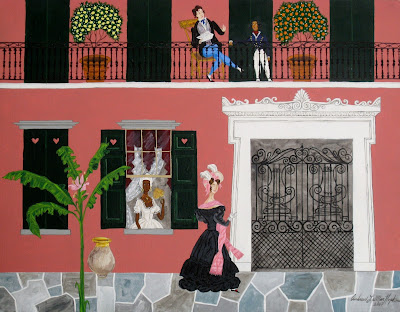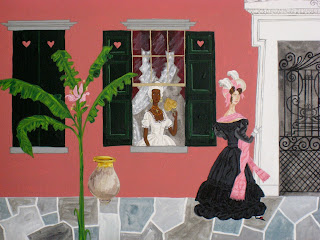"Micaela Almonester de Pontalba visits Creole New Orleans in 1830"
My latest Masterpiece is tilted "Micaela Almonester de Pontalba visits Creole New Orleans in 1830". It depicts Micaela Leonarda Antonia Almonester y Rojas, Baroness de Pontalba (November 6, 1795- April 20, 1874) a wealthy New Orleans-born Creole aristocrat, businesswoman, and real estate developer, and one of the most dynamic personalities of that city's history. Micaela is depicted in the latest fashion from Paris, walking down the flagstone sidewalk in front of a New Orleans Greek Revival house of a New Orleans mix race couple and child. On the flagstone sidewalk is a small a French Olive jar next to a miniature banana tree. And a Neoclassical wrought iron gated carriage passage known as a porte-cochère in New Orleans, connected the street to a rear courtyard. Over her head on a Neoclassical cast iron balcony, a white Creole father holding a Times-Picayune newspaper next to his mix race son with potted lemon and orange trees on the balcony. Below the Free woman of color mother looks out a open window holding a palm fan.
Micaela Almonester de Pontalba visited New Orleans two times after her arranged marriage in 1811 to her 20-year-old cousin, Xavier Célestin Delfau de Pontalba, known as Celestin or "Tin Tin". Micaela was 15 at the time of her marriage. She traveled to New Orleans in 1830 and 1848, both years of Revolutions in France as well as with her husband family with a series of lawsuits against her. In 1830, without her husband's permission, she went to New Orleans for an extended visit, taking the opportunity to travel around other parts of the United States. She stopped in Washington DC where President Andrew Jackson sent his own carriage and secretary of state Martin Van Buren to bring her to the White House as his guest. The celebrated Battle of New Orleans in which Jackson had defeated the invading British on 8 January 1815 had been fought on the grounds of the Chalmette Plantation belonging to her uncle and aunt. Upon her return to France the baron accused her of deserting Célestin; as a result she became a "virtual prisoner" of the de Pontalbas. In frustration, she took her children and transferred back to Paris where she began a series of lawsuits to obtain a separation from Célestin, but lost them due to the strict French marriage laws.
Micaela Baroness de Pontalba was perhaps the most interesting historical woman from New Orleans and one of the most dynamic personalities of that city's history. My association with the Micaela Baroness de Pontalba is I worked in the 1850 House Museum on Jackson Square. Two Summers ago I visited Mont-l'Évêque the moated, medieval de Pontalba chateau outside Senlis which was about 50 miles from Paris, still lived in by the Pontalba family. Micaela was born in New Orleans in November 6, 1795. Her mother a French Creole was Louise Denis de la Ronde a member of one of the most illustrious Creole families in Louisiana.. Her Spanish father, Andrés Almonester y Rojas was a Spanish civil servant of New Orleans.
"an office rich in salary, perquisites, and business opportunities. He soon acquired wealth in it, or through it." Among his investments was a large tract of land downtown, purchased from Governor O'Reilly on perpetual lease. Upon the death of her Spanish father, Andrés Almonester y Rojas in 1798, Micaela, as his only surviving child, inherited a considerable fortune; although the estate was controlled by her mother, Louise Denis de la Ronde. Being the sole heiress to a considerable fortune, Micaela was likely the richest girl in the city of New Orleans if not the state of Louisiana. Following her marriage in 1811 to her French cousin, Xavier Célestin Delfau de Pontalba, she moved to France. The marriage was not successful and she became a virtual prisoner at the de Pontalba chateau near Senlis.
Having failed to gain possession of her entire inheritance, her father-in-law, Baron de Pontalba shot her four times at point-blank range with a pair of dueling pistols and then committed suicide. She survived the attack, although her left breast and two of her fingers were mutilated by gunfire. Her husband, Cèlestin succeeded his father as baron, and Micaela was henceforth styled Baroness de Pontalba. She eventually obtained a legal separation from him. Micaela was responsible for the design and construction of the famous Pontalba Buildings in Jackson Square, in the heart of the French Quarter. In 1855, she built the Hôtel de Pontalba in Paris, where she lived until her death in 1874. Her life was worthy of an operatic plot, and eventually became one: Pontalba: a Louisiana Legacy, composed by Thea Musgrave. A play by Diana E.H. Shortes entitled The Baroness Undressed, and several novels, are also based on her dramatic life.
14 x 18 Available https://squareup.com/store/andrew-hopkins/item/micaela-almonester-de-pontalba-visits-creole-new-orleans-in






















Lovely. The future baronne is très à la mode; I love her flounces and her dainty shoe.
ReplyDeleteAs I told you, I'm finally reading "Intimate Enemies". Been reading it for a while, actually, and - still - haven't gotten to the lady depicted here. But I'm certainly learning a lot about New Orleans at the beginning of the nineteenth century. : )
The first time I read the book I did not get into the first part about 18th century New Orleans until I met the family and then I reread the book and it all came alive to me. I have now read the book about 4 times!
ReplyDelete: )
ReplyDeleteLovely to see this fetching painting of my second cousin in all her glory. Thank you for sharing!
ReplyDelete